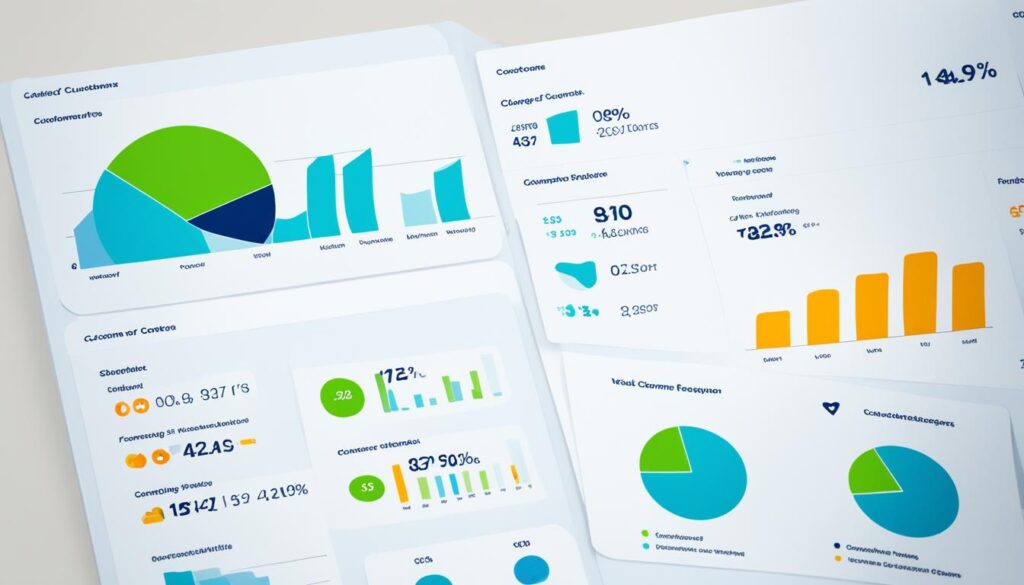Are you confident that your customers are truly satisfied with your business? How do you know if they’re happy or if there are areas that need improvement? Customer satisfaction is a crucial aspect of any successful business, and understanding how to measure it is the key to unlocking growth and success.
Customer satisfaction metrics offer valuable insights into the overall experience customers have with your business. By tracking these metrics, you can gauge customer sentiment, identify strengths and weaknesses, and make data-driven improvements to enhance the customer experience.
So, how exactly can you measure customer service satisfaction? What are the most effective metrics to track? And how can you leverage this information to drive customer loyalty and business growth? In this article, we will explore the answers to these questions and provide you with actionable insights to measure and improve customer service satisfaction.
The Importance of Measuring Customer Satisfaction
Measuring customer satisfaction is crucial for businesses as it has tangible benefits that directly impact success. When customers are highly satisfied, they are more likely to develop loyalty towards your brand, make repeat purchases, and recommend your products or services to others. The loyal customer base you build through customer satisfaction not only contributes to increased revenue but also serves as a powerful marketing tool through word-of-mouth recommendations.
In times of economic uncertainty, customer experience becomes even more critical. Customers prioritize their overall experience over cost when making purchasing decisions. By ensuring a positive customer experience and high satisfaction levels, you can differentiate your brand from competitors and gain a competitive edge. Investing in customer satisfaction can lead to significant cost savings by reducing customer churn and the need for extensive marketing efforts to acquire new customers.
According to a report by Bain & Company, increasing customer retention rates by just 5% can increase profits by 25% to 95%.
Improving customer satisfaction not only benefits the individual customers but also contributes to the overall growth and success of your business. Satisfied customers are more likely to engage with your brand, provide valuable feedback, and become brand advocates. They can contribute to product innovation, provide insights for enhancement, and even participate in beta testing of new offerings.
Research conducted by Temkin Group shows that customers who have a positive customer experience are 3.5 times more likely to repurchase and 5 times more likely to recommend the company to others.
In addition to driving revenue, customer satisfaction is also crucial for long-term business sustainability. By consistently delivering exceptional customer experiences, businesses can build strong customer relationships, withstand market fluctuations, and sustain growth over time.
According to a study by PwC, over 50% of customers say they would switch to a competitor after just one negative experience with a brand.
Overall, measuring customer satisfaction and prioritizing customer experience are vital business strategies that offer numerous benefits, including increased customer loyalty, improved revenue, and long-term business growth.

Key Customer Satisfaction Metrics to Track
When it comes to measuring customer satisfaction, businesses need to track key metrics that provide valuable insights into the overall customer experience. By monitoring these metrics, businesses can identify areas for improvement and make data-driven decisions to enhance customer satisfaction.
The Overall Satisfaction Measure
The overall satisfaction measure reflects the general opinion of customers regarding their satisfaction with a product or service. It provides a holistic view of how well your brand is meeting customer expectations and delivering on its promises. By tracking this metric, businesses can gauge the overall satisfaction levels of their customer base.
Customer Loyalty Measurement
Customer loyalty is a crucial aspect of customer satisfaction. This metric focuses on assessing the likelihood of customers to repurchase from or recommend a brand to others. A loyal customer is not only satisfied with their experience but also has a strong connection and trust in the brand. By measuring customer loyalty, businesses can identify their most loyal customers and cultivate long-term relationships.
Attribute Satisfaction Measurements
Attribute satisfaction measurements involve assessing customer satisfaction with specific attributes or aspects of a product or service. This could include factors such as taste, reliability, ease of use, or customer service. By tracking attribute satisfaction, businesses can pinpoint strengths and weaknesses in their offerings and make targeted improvements to enhance the overall customer experience.
Intentions to Repurchase Measurements
Intentions to repurchase measurements gauge customers’ likelihood to return to a business in the future. This metric provides insights into customer loyalty and repeat business. By understanding customers’ intentions to repurchase, businesses can determine the effectiveness of their strategies and identify areas that may need attention to increase customer retention.
By tracking these key customer satisfaction metrics, businesses can gain valuable insights into the overall satisfaction levels of their customers. This data can be used to drive continuous improvements, enhance the customer experience, and ultimately, foster customer loyalty and business growth.
How to Develop Customer Satisfaction KPIs
To effectively measure customer satisfaction, businesses need to develop key performance indicators (KPIs) that align with their goals and objectives. By establishing these KPIs, you can track your progress and make informed decisions for improving customer satisfaction. Here are some steps to help you develop customer satisfaction KPIs:
- Define your customer satisfaction goals: Start by identifying what you want to achieve in terms of customer satisfaction. Do you want to increase your customer satisfaction score, improve customer loyalty, or enhance the overall customer experience? Clearly define your goals so that you have a clear direction.
- Set realistic targets: It’s important to set realistic targets for your customer satisfaction scores. Consider your industry benchmarks and your past customer satisfaction scores as reference points. This will help you set achievable goals that drive improvement.
- Gather customer feedback: Feedback from your customers is invaluable in understanding their needs, preferences, and pain points. Implement customer feedback surveys, focus groups, or online reviews to gather insights and identify areas for improvement. Analyze this feedback to inform your KPIs and adjust your strategies accordingly.
- Choose relevant metrics: Select the customer satisfaction metrics that align with your goals and capture the essence of customer satisfaction in your industry. These may include customer satisfaction scores, Net Promoter Score (NPS), or Customer Effort Score (CES). Determine the frequency of measurement to track your progress effectively.
- Monitor and measure: Implement a system for continuous monitoring and measuring of your customer satisfaction KPIs. Regularly review your performance against your targets and identify any areas for improvement. Use this information to fine-tune your strategies and actions.
By following these steps, you can develop meaningful and actionable customer satisfaction KPIs that align with your business goals. Remember, customer satisfaction is a dynamic measure, so it’s essential to regularly reassess and adjust your KPIs based on customer feedback and industry benchmarks.

| KPI | Definition | Measurement |
|---|---|---|
| Overall Customer Satisfaction Score | Assessment of overall customer satisfaction with your product or service | Scale of 1-10 or 1-5 rating |
| Net Promoter Score (NPS) | Measure of customer loyalty and likelihood to recommend your brand | Range from -100 to +100 |
| Customer Effort Score (CES) | Assessment of the ease with which customers can accomplish their goals | Scale of 1-7 or 1-5 rating |
| Customer Retention Rate | Percentage of customers who continue to purchase from your brand over a specific period | Percentage |
Tools and Methods to Measure Customer Satisfaction
Measuring customer satisfaction is essential for businesses to understand how well they are meeting their customers’ needs and expectations. By gathering feedback and insights from customers, businesses can make informed decisions to improve customer satisfaction. There are several effective tools and methods available to measure customer satisfaction:
Customer Satisfaction Surveys
Customer satisfaction surveys, such as CSAT surveys, provide valuable insights into customer opinions and experiences. These surveys typically include questions about overall satisfaction, specific aspects of the product or service, and the likelihood of recommending the brand to others. By analyzing survey responses, businesses can identify areas for improvement and prioritize strategies for enhancing customer satisfaction.
Focus Groups and Advisory Boards
Engaging directly with customers through focus groups and advisory boards allows businesses to gather qualitative feedback on their products, services, and overall customer experience. These sessions provide an opportunity for customers to share their thoughts, opinions, and suggestions, providing valuable insights into their satisfaction levels. By actively listening to customer feedback, businesses can make adjustments and improvements that align with customers’ expectations and preferences.
Social Media Monitoring
Social media platforms are a treasure trove of customer feedback. By monitoring comments, reviews, and messages about your brand on social media, businesses can gauge customer satisfaction levels and identify areas for improvement. Social media monitoring tools enable businesses to track and analyze conversations and sentiment about their brand, helping them to identify trends, address concerns, and capitalize on positive feedback.

Customer Feedback Analysis
Analyzing and interpreting customer feedback is crucial for understanding customer satisfaction. This can be done through sentiment analysis, text analytics, and other data-driven techniques. By categorizing and analyzing customer feedback, businesses can gain insights into common pain points, recurring issues, and areas where they are excelling. This enables them to take targeted actions to improve customer satisfaction and address customer concerns effectively.
By utilizing these tools and methods to measure customer satisfaction, businesses can gain valuable insights, make data-driven decisions, and continuously improve the customer experience. Understanding customer needs and preferences will result in increased customer satisfaction, loyalty, and ultimately, business success.
Tips for Improving Customer Satisfaction
Improving customer satisfaction requires businesses to take action based on customer feedback. By analyzing survey data and customer feedback, businesses can identify areas for improvement and make necessary changes. This may involve improving customer support interactions, enhancing the overall customer experience, or optimizing product quality and reliability. It’s also important to regularly assess customer satisfaction levels and make adjustments as needed. By continuously striving to improve customer satisfaction, businesses can build stronger customer relationships and drive business growth.
To optimize customer support interactions, businesses should focus on providing prompt and helpful responses to customer inquiries and issues. This can be achieved by training support staff to be knowledgeable and empathetic, and by implementing efficient communication channels such as live chat or email.
Enhancing the overall customer experience involves creating a seamless and enjoyable journey for customers at every touchpoint. This includes streamlining processes, improving website navigation, and personalizing interactions to meet individual customer needs and preferences.
Optimizing product quality and reliability is crucial in meeting customer expectations. Businesses should strive to deliver products that are of high quality, durable, and perform as advertised. Regularly gathering customer feedback can help identify areas for improvement and ensure that products meet or exceed customer expectations.
Conclusion
Measuring customer satisfaction is crucial for businesses to understand how well they are meeting customer expectations. By tracking customer satisfaction metrics and using customer feedback to make improvements, businesses can enhance the customer experience, drive customer loyalty, and ultimately achieve business growth.
When customers are satisfied with their experience, they are more likely to become loyal patrons and repeat customers. This can lead to increased sales and revenue, as well as positive word-of-mouth recommendations that can further expand customer reach. Prioritizing customer satisfaction is essential in today’s competitive market where customers have numerous options to choose from.
By continuously monitoring and improving customer satisfaction, businesses not only ensure the retention of existing customers but also attract new ones. Satisfied customers are more likely to engage in repeat business and refer your brand to friends and family, resulting in a growing customer base and a positive brand reputation. Therefore, prioritizing customer satisfaction should be a top priority for businesses that aim to succeed and thrive in the long term.
FAQ
How can I measure customer service satisfaction?
Customer service satisfaction can be measured using various metrics such as customer satisfaction surveys, customer loyalty measurements, attribute satisfaction measurements, and intentions to repurchase measurements.
Why is measuring customer satisfaction important?
Measuring customer satisfaction is important because it reflects the overall experience customers have with your business, impacts their loyalty, and influences their likelihood to recommend your brand. It also allows you to identify areas for improvement and track your progress over time.
What are some key customer satisfaction metrics to track?
Key customer satisfaction metrics include the overall satisfaction measure, customer loyalty measurement, attribute satisfaction measurements, and intentions to repurchase measurements.
How can I develop customer satisfaction KPIs?
To develop customer satisfaction KPIs, you need to define your goals and outline a plan of action. Set realistic goals based on past customer satisfaction scores or industry benchmarks and consider customer feedback to adjust strategies accordingly.
What tools and methods can I use to measure customer satisfaction?
You can use customer satisfaction surveys, focus groups, advisory boards, and social media monitoring to gather customer feedback and measure satisfaction.
How can I improve customer satisfaction?
To improve customer satisfaction, analyze survey data and feedback, identify areas for improvement, and take necessary actions such as enhancing customer support interactions, optimizing the overall customer experience, and improving product quality and reliability.
Why is customer satisfaction important for business growth?
Customer satisfaction is important for business growth because highly satisfied customers are more likely to be loyal, make repeat purchases, and recommend your brand. It can lead to cost savings, increased revenue, and strengthen customer relationships.
